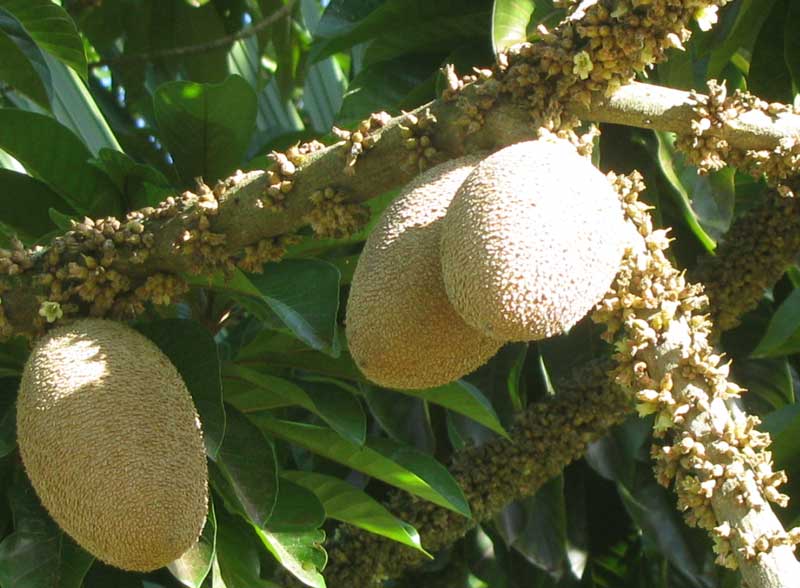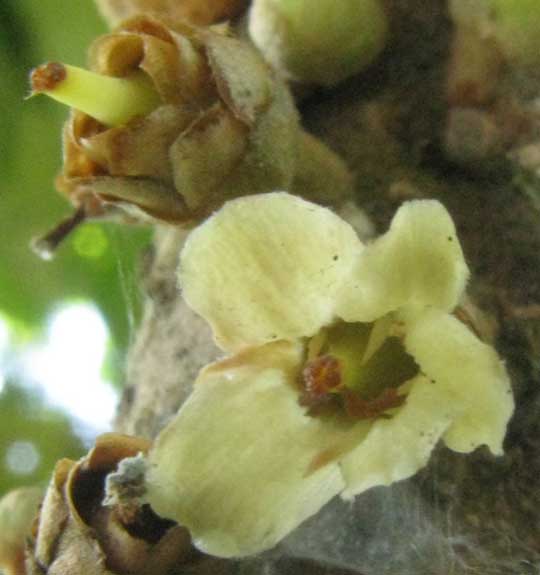Excerpts from Jim Conrad's
Naturalist Newsletter

from the December 11, 2011 Newsletter issued from Hacienda Chichen Resort beside Chichén Itzá Ruins, central Yucatán, MÉXICO; limestone bedrock, elevation ~39m (~128ft), ~N20.676°, ~W88.569°
MAMEYS FLOWERING & FRUITING
Normally we think of a plant's flowering time preceding and separate from its fruiting time. Sometimes, however, flowering and fruiting overlap. That's the case nowadays with Mamey trees, as shown above. Those unripe fruits are about three inches long (8cm). Eventually some of them may reach double that size, and when they do they'll offer themselves as one of the world's most delicious of tropical fruits.
You can see that one curious thing about the pea-sized flowers is that they are almost stemless and grow densely along the tree's thick branches. Other neat features about them are shown in the close-up below:

At that picture's top, left you see a recently pollinated blossom in which the corolla has been shed, falling off in one piece. The green fingerlike item poking out of the brown nestlike thing is the style, the ovary's "neck," atop which was the stigma on which pollen grains germinated. The brown nestlike thing is the calyx, which is unusual because it has ten sepals, or calyx lobes, instead of the expected five, and the lobes overlap like shingles on a roof -- they're densely "imbricated" in several series, the books say.
Lower down, a younger blossom retains its whitish, five-lobed corolla. The notable feature about it is that the corolla lobes alternate with slender "staminodia." Staminodia are thought of as sterile stamens, or features that arise where you'd expect stamens to arise.
In the field, if you see a flower with such overlapping sepals and staminodia alternating with the petals, you just have to think of the Mamey's family, the Sapodilla Family, or Sapotaceae. In the tropics worldwide that's a good family to know, because it so often produces scrumptious fruit. Beside mameys, there are chicozapote or sapodilla, canistel, and star-apple or caimito fruits.
The Mamey tree, POUTERIA SAPOTA, is a native tropical American tree, probably including southern Mexico, but it's not found in our local forests. It is, however, planted in the tropics worldwide for its wonderful fruit.
from the November 8, 2009 Newsletter issued from Hacienda Chichen Resort beside Chichén Itzá Ruins, central Yucatán, MÉXICO; limestone bedrock, elevation ~39m (~128ft), ~N20.676°, ~W88.569°
AN EASY MAMEY
Below is a perfectly formed, softball-size mamey fruit, the Mamey tree being POUTERIA SAPOTA, a member of the Sapote Family, the Sapotaceae.

Mamey fruits have a custardy texture and the flesh is "bright burned-magenta-orange," according to one color-savvy person. Inside there's a single large, shiny seed. The taste is very sweet and a little musky but otherwise indescribable, and delicious, at least to those of us with tropical headsets and dispositions.